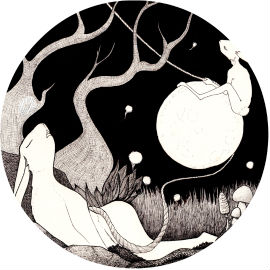 A Monster Calls is a young adult novel, featuring stunning occasional illustrations by Jim Kay. The story was first conceived by Siobhan Dowd, a well-known children’s writer, but when she passed away before she could complete the work her publisher, Walker Books, commissioned Ness to complete the work. In subsequent interviews, Ness has described the process as being like a ‘conversation’ between himself and Dowd:
A Monster Calls is a young adult novel, featuring stunning occasional illustrations by Jim Kay. The story was first conceived by Siobhan Dowd, a well-known children’s writer, but when she passed away before she could complete the work her publisher, Walker Books, commissioned Ness to complete the work. In subsequent interviews, Ness has described the process as being like a ‘conversation’ between himself and Dowd:
… and that mostly it was me saying, “Just look what we’re getting away with.”
The book tells the story of a few short months in the life of 13-year-old Conor, whose father has left his mother for a new wife, baby and life in America, and whose mother is undergoing chemotherapy.
Conor, unsurprisingly, is having nightmares and is not doing so well at school, either socially or academically, though everyone around him seems determined to ignore his failures. To make allowances. The book opens when Conor wakes from a nightmare at 12:07 and hears a voice calling to him through the bedroom window. It is the monster, Cernunnos, who is calling to him. Cernunnos is not a nightmare, not the nightmare. He – it – is something else entirely. A magical, difficult figure who tells him stories he doesn’t want to hear, and in which the moral messages are not the safe, expected ones Conor is used to. Kay’s illustrations beautifully capture the wild, enormous, dark beauty of Conor’s midnight companion.
The book is wholly emotionally engaging. In some ways, the story of a boy dealing with the fallout of his family falling apart is a bit of a cliché. There are a slew of books dealing with dark and difficult themes for readers of this age. And the use of magic, or a magical creature, as a way for a young protagonist to externalise and deal with his emotions is also a fairly common trope of (young adult) fiction. So, in some ways, the book is not strikingly original. The yew-tree manifestation of Cernunnos that comes walking because Conor has called him is powerful, contrary, unpredictable: as are Conor’s emotions. But originality of subject, and major themes, is not – I think – a prerequisite for successful fiction. This book, certainly, speaks to the value of a book that deals with old themes in a slightly new way, is moving, powerful, simply told. Honest. Unflinching.
One of the things I really enjoyed in the book was the way it overturned some of the reader’s expectations. Drawing you into thinking the narrative was going to do x, and then doing y. Zigging when you thought it would zag. I loved, for example, that the monster tells Conor that part of the efficacy of herbal cures comes from belief. That you have to have, and keep, faith. This is one of the ‘morals’ of one of the stories the monster tells Conor: that to betray your faith is a terrible, punishable thing. So far, so predictable. But then, Conor does have faith and faith does not, as it might in a Hollywood movie, mean that what he believes in works. No amount of clapping and saying I do believe in fairies will make fairies live, in this story. This is the real world, where belief matters, where fidelity of faith matters, but not because it can change things.
This ‘message’ is one that has stayed with me. Haunted me. At an event at Avid Reader last year, Michelle de Kretser talked about how a good book haunts her, as a reader and as a writer. This aspect of this book certainly haunts me. I am still thinking about the role of belief and faith in a secular, modern world. Like Cernunnos, I would insist that it is important. That you have to believe, even when you *know* that what you believe in is not real. Romantic love. The perfection of your children. The importance of grieving to those who have passed on. Your belief sustains something essential in the world.
I read this book on a cold, snowy day in Haarlem. With a pot of tea and a perfect view of trees out the window. And I cried through the last three or four chapters. Even though I knew what was coming. Of course I knew. You will know, too, when you read it, what is coming. You can feel it, bulking there like a horrid beast. Dark and relentlessly patient. And yet, you will want to share Conor’s belief in magic, as I did. You will want his believing to change things, even though you know it won’t. Not in the real world. Not in the world this book, in the end, so vividly inhabits.
It’s a beautiful book. Full of sad and beautiful things. Anger, and love, and beauty. And truth. Terrible, fragile truth.
Note: I would strongly advise you NOT to buy the repackaged ‘adult’ version of this book, which does not include the absolutely beautiful black and white drawings by Jim Kay. They are a powerful part of the book. I think it’s a terrible, sad thing that the adult edition does not include them.
Details
- Published by Walker Books in the UK, 2011 (2012 in Australia)
- 216 pp
- $AU16.95 paperback
- ISBN: 9781406339345
- Winner of the Carnegie and Kate Greenaway Medals for children’s books (writing and illustration), British Children’s Book of the Year, Red House Children’s Book Award, and the Kitschies Red Tentacle Award.
More

No Comments